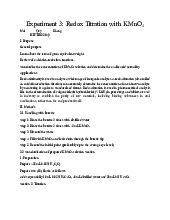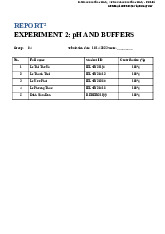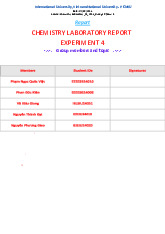












Preview text:
VIETNAM NATIONAL UNIVERSITY – HO CHI MINH
CITY INTERNATIONAL UNIVERSITY CHEMISTRY LAB REPORT EXPERIMENT 2: pH and Buffers
Instructor: Lê Trần Hồng Ngọc Name: Võ Thị Thảo Vy ID: BTBTIU22187 Group: 16
Academic year: 2023-2024 1 I/ Introduction
By the Arrhenius theory, acid and base are the two substances that dissociate in water to form hydronium ion (H -
3O+) and hydroxide (OH ) ion, respectively. According to Lewis-
Brønsted theory, an acid is a proton donor, and a base is a proton acceptor. Strong
acid/strong base complete dissociate in aqueous solution to form H3O+ and OH-,
respectively. However, Weak acid/base dissociate only partly and forms little or a few H3O+/OH- in aqueous solution. Acid: HA (aq) + H - 2O H ↔ 3O+ (aq) + A (aq) Ka Base: A- (aq) + H - 2O ↔ HA (aq) + OH (aq) Kb We have: Ka = ¿ ¿ ¿ -14 0 K K b = [ HA ] ¿ ¿ a x Kb = Kwater = 1.0 x 10 at 25 C
pH scale: specify the acidity of a solution. pH = -log[H + 3O ]
pH < 7 => Acidic solution.
pH > 7 => Basic solution.
pH = 7 => Neutral solution. A
buffer is a solution which contains a weak acid or weak base and its conjugate weak
base or weak acid, respectively. Buffers is used to resist a large change in pH on the addition of H+ or OH-.
Dilution is the process of reducing the concentration of a solution by adding solvent into that solution. We have: ni=nf Mi x Vi = Mf x Vf
Where: Mi is the initial solution concentration (M)
Vi is the initial solution volume needed for dilution (mL)
Mf is the final solution concentration after dilution (M)
Vf is the final solution volume after dilution (mL) II/ Objectives 2
To differentiate between strong and weak acid.
To know the way to eliminate and prepare a buffer solution and test its buffering ability. III/ Materials equipment. 1/. Materials 0.1M HCl 0.1M CH3COONa 0.1M NaOH Deionized water 0.1M CH3COOH Distilled water 0.1M NH4Cl 2/. Equipment Tray 250 mL beaker 10 mL graduated pipette Stirring rod Green pump pH meter 100 mL cylinder Plastic pipette 100 mL volumetric flask Marker 100 mL beaker IV/ Procedure Dilution process:
(1) First take the needed volume of initial solution (Vi) by pipette.
(2) Transfer the needed volume into volumetric flask.
(3) Add solvent into the volumetric flask until the solution reaches the marked level of flask (meniscus).
(4) Close the cap and shake the flask gently. 1/. Deionized water
Step 1: Pour ~50mL deionized water (by cylinder and beaker), continuously stir in 20 seconds, then record the pH.
Step 2: Continue stir in 20 seconds, then record the pH.
Step 3: Keep doing the same procedure until there is no significant change in pH value. 3 2/. Strong acid Section 1: Preparation
Using 10mL graduated pipette and volumetric flask: Take ~10mL 0.1M HCl. Take ~20mL 0.1M NaOH.
Prepare 100ml 0.01M NaOH solution (10mL 0.1M NaOH: 90mL H2O).
Check the dilution process above.
Section 2: pH measurement
Step 1: Use 10mL graduated pipette to take 10mL 0.1M HCl, then record pH.
Step 2: Add 90mL distilled water, stirring in a few seconds then record the pH.
Step 3: Add 10mL 0.1M 0.1M NaOH, stirring in a few seconds then record the pH.
Step 4: Add 90mL 0.01M NaOH, stirring in a few seconds then record the pH. 3/. Weak acid Section 1: Preparation
Using 10mL graduated pipette and volumetric flask: Solution A: 0.1M CH3COOH.
Solution B: 0.01M CH3COOH (dilute solution A 10 times).
Solution C: 0.001M CH3COOH (dilute solution A 100 times or dilute solution B 10 times).
Check the dilution process above.
Section 2: pH measurement Step 1: Take 20mL solution A. Step 2: Take 20mL solution B. Record pH, Ka Step 3: Take 20mL solution C. 4/. Salts Section 1: Preparation Solution A: 0.1M NaCl Solution B: 0.1M CH3COONa Solution C: 0.1M NH4Cl 4
Section 2: pH measurement Step 1: Take 20mL solution A. Step 2: Take 20mL solution B. Record pH, Ka Step 3: Take 20mL solution C. 5/. Buffers Section 1: Preparation
Using 100mL cylinder and beaker to prepare these following solutions: (1) ~50mL 0.1M CH3COOH (2) ~50mL 0.1M CH3COONa (3) ~40mL 0.1M HCl (4) ~40mL 0.1M NaOH Section 2: Buffer A
Step 1: Add 10mL 0.1M CH3COOH and 40mL 0.1M CH3COONa into one beaker, label
Buffer A (50mL). Then record pH two times.
Step 2: Divide buffer A equally, label A1 (25mL) and A2 (25mL), then record pH each two buffers.
Step 3: Add 10 drops 0.1M HCl and 10 drops 0.1M NaOH into buffers A1 and A2, respectively.
Step 4: Add more drops 0.1M HCl into buffer A1 and more drops 0.1M NaOH into
buffer A2, record VHCl and VNaOH (in drops) until the pH changes by one unit from the start. Section 3: Buffer 3
Step 1: Add 40mL 0.1M CH3COOH and 10mL 0.1M CH3COONa into one beaker, label
Buffer B (50mL). Then record pH two times.
Step 2: Divide buffer B equally, label B1 (25mL) and B2 (25mL), then record pH each two buffers.
Step 3: Add 10 drops 0.1M HCl and 10 drops 0.1M NaOH into buffers A1 and A2, respectively. 5
Step 4: Add more drops 0.1M HCl into buffer A1 and more drops 0.1M NaOH into
buffer A2, record VHCl and VNaOH (in drops) until the pH changes by one unit from the start. III/ Result and explanation. 1/. Deionized water Time Observed pH (second) 1st 2nd (other group in (My result) the class) (Group 2) 0 7.73 20 8.61 7.20 40 8.23 7.54 60 7.59 7.20 80 7.27 7.27 100 6.95 7.32 120 6.73 7.30 140 6.54 7.27 160 6.40 7.31 180 6.23 200 6.11 220 6.07 Explanation:
Consider my experiment, after doing a series of recording pH, I observed that pH only
decreases from 8.61 to 6.07 and the value of pH did not focus on any constant value
although by the theory, pH of deionized water is around 7. For me, there is two reasons
to explain how my pH result is decreased as the above sheet:
1. The deionized water was not completely dissolved all the ions, so the large
differences in the ionic strength of the sample (the deionized water) and the buffer
solution of the pH electrode cause unreliable readings.
2. My stirring rod is not clear. It means that there was a few amounts of acid/base on the stirring rod.
Compare to my results, the results of group 2 has higher accuracy and high precision. 2/. Strong acid. Ordina Solution Theoretical Measure pH 6 l pH 1st (My 2nd group) (Group 2) 1 10mL of 0.1M HCl 1.00 1.37 1.70 2 + 90mL of distilled water 2.00 2.10 2.42 3 + 10mL of 0.1M NaOH 7.00 3.27 4.31 4 + 90mL of 0.01M NaOH 11.65 11.29 11.75 Explanation:
The concentration of H+ on 10mL of 0.1M HCl is:[H+] = 0.1M => pH = -log[H+] = 1
Consider 10mL of 0.1M HCl, we have: nHCl = MHCL x V = 0.1 x 10 = 1 mol.
When add 90mL more of distilled water, the previous solution becomes 100mL. 1
Due to ni = nf, the molarity in this time is: MHCL = = 0.01 (mol/mL) 100
So that [H+] = 0.01 => pH = -log[H+] = 2
Add 10mL of 0.1M NaOH more into this solution, we have nNaOH = 1 = nHCl
Due to NaOH + HCl → NaCl (salt) + H + -
2O with 1:1 ratio of mol, so ion H and OH
completely react with each other to form H2O, our solution is neutral => pH = 7.
When add more 90mL of 0.01M NaOH into 110mL of 0.01M HCl, the solution in this time becomes 200mL. 0.9 n -3 - -3
NaOH = 0.01 x 90 = 0.9 => MNaOH = = 4.5x10 => [OH ] = 4.5x10 200
So that pOH = -log[OH-] = 2.35 => pH = 14 – 2.35 = 11.65.
My group (Group 4) and Group 2 have high accuracy compared to the theoretical
pH. However, the third step (+ 10mL of 0.1M NaOH) had a significant difference
in comparison with the theoretical pH. Perhaps the concentration on the solution
distributed unequally or our stirring rod did not clear after we used to stir the
solution on the first or the second step. 3/. Weak acid Solution Measure pH Average Ka 1st (My group) 2nd (Group 2) 7 0.1M acetic acid 2.96 2.67 1.22 x 10-5 0.01M acetic acid 3.63 3.18 5.63 x 10-6 0.001M acetic acid 5.62 4.23 5.77 x 10-9 Explanation:
CH3COOH is dissociated by the following equation: CH - 3COOH CH ↔ 3COO + H+ With 1:1 rotation of C
M , mol, and the volume before and after the process of dissociation. On 0.1M CH + - -2.96
3COOH: [H ] = [CH3COO ] = [CH3COOH] (dissociated)= 10 ( −2.96 10 )2 => K = = a 1.22 x 10-5 0.1 10 − −2.96
(0.1– 10-2.96) is the remain of molarity of CH3COOH that did not dissociate.
Correspond to the solution of 0.1M acetic acid, we can calculate Ka in other cases.
On 0.01 CH3COOH: [H+] = [CH3COO-] = [CH -3.63 3COOH] (dissociated)= 10 ( −3.63 10 )2 => K = = a 5.63 x 10-6 0.01 10 − −3.63
On 0.001 CH3COOH: [H+] = [CH3COO-] = [CH -5.62 3COOH] (dissociated)= 10 ( −5.62 10 )2 => K = = a 5.77 x 10-9 0.001 10 − −5.62 4/. pH of Salts Solution Predicted pH Measure pH 1st (My group) 2nd (Group 2) 0.1M NaCl ~7.00 7.39 4.75 0.1M CH3COONa ~8.00 6.96 6.95 0.1M NH4Cl ~5.60 6.27 4.80 Explanation:
NaCl is salt which is formed by strong base (Na+) and strong acid (Cl-), so the
solution is nearly neutral, we predicted that pH is approximately 7.00. In the first
measurement, our result is more accurate than Group 2. 8 CH +
3COONa is salt which is formed by strong base (Na ) and weak acid (CH -
3COO ), so the solution had more base characteristics. We predicted that pH is
greater than 7, particularly approximately 8.0.
NH4Cl is salt which is formed by weak base (NH4+) and strong acid (Cl-), so the
solution had more acid characteristics. We predicted that pH is smaller than 7,
particularly approximately 5.6.
Our results measurement pH of NaCl and NH4Cl is quite same with the
prediction. However, in the measurement pH of CH3COONa, the result we got is
not the same as we thought, perhaps some mistake such as the equipment, or the
distribution of the concentration in the solution. 5/. pH of buffers Buffer Volume Volume
[Acid] [Base] Calculated Measured pH (mL) 0.1M (mL) 0.1M pH 1st (My 2nd CH3COOH CH3COONa group) A 10 40 0.02 0.08 5.34 First time: 5.13 Second time: 5.12 B 40 10 0.08 0.02 4.14 First time: 4.03 Second time: 4.02 Explanation:
nCH3COOH = 0.1M x 10mL = 1 mol.
nCH3COONa = 0.1M x 40mL = 4 mol. 1 CM of CH3COOH in buffer A is: = 0.02 mol/mL. 50 4
CM of CH3COONa in buffer A is: = 0.08 mol/mL. 50
CH3COOH and CH3COONa are dissociated by the following equation: CH - 3COOH ↔ CH3COO + H+
1:1 rotation of mol => 1:1 rotation of CH - molarity. 3COONa ↔ CH3COO + Na+ So we have: 9 [Acid] = [H+] = 0.02 mol/mL. [Base] = [Na+] = 0.08 mol/mL.
The Acid dissociation constant (K -5 a) of CH3COOH is: 1.8 x 10 . pK -5
a = -log(Ka) = -log(1.8 x 10 ) = 4.74 [base]
Then we have the formular: pH = pKa + log [acid] 0.08
pH of buffer A is: 4.74 + log = 5.34 0.02
Compared to the calculated pH, our results have high accuracy with 5.13 and 5.12 by two times of measurement.
Correspondingly, we calculated [Acid] and [Base] of buffer B is 0.08 and 0.02, respectively. 0.02
Then the pH of buffer B is: 4.74 + log = 4.14 0.08
Compared to the calculated pH, our results have high accuracy with 4.03 and 4.02 by two times of measurement.
Part I: Addition of 10 drops of 0.1M HCl Buffer pH from the pH after adding 10
Total volume of HCl (drops) start (pH0) drops of 0.1M HCl
to change by one unit (pH0-1) A1 5.11 5.10 213 drops_ 8mL (pH = 4.14) B1 4.03 3.98 133 drops_ 5mL (pH= 2.83) Explanation: CH -
3COOH is weak acid which dissociates partly to form CH3COO + H+ CH - +
3COONa is salt which is formed by weak acid (CH3COO ) and strong base (Na ) and dissociated completely.
Due to [Acid] of buffer B is greater than buffer A, the initial pH of buffer B is smaller
than buffer A (4.14 and 5.34). So, the pH in buffer B1 is also smaller than buffer A1 (4.03 and 5.11). 10
When adding more HCl (strong acid) into buffer A1, this substance dissociated
completely to form H+ and Cl-. Then H+ of HCl reacted with CH3COO- in A1 and B1
solution to form CH3COOH => pH decreases.
Part II: Addition of 10 drops of 0.1M NaOH. Buffer pH from the pH after adding 10
Total volume of HCl (drops) start (pH0) drops of 0.1M NaOH
to change by one unit (pH0+1) A2 5.13 5.16 133 drops_ 5mL (pH = 6.18) B2 3.98 4.04 279 drops_ 10.5mL (pH= 5.00) Explanation: CH -
3COOH is weak acid which dissociates partly to form CH3COO + H+ CH - +
3COONa is salt which is formed by weak acid (CH3COO ) and strong base (Na ) and dissociated completely.
Due to [Acid] of buffer B is greater than buffer A, the initial pH of buffer B is smaller
than buffer A (4.14 and 5.34). So, the pH in buffer B2 is also smaller than buffer A2 (3.98 and 5.13).
When adding more NaOH into buffer A2 and B2, NaOH is dissociated to form ions Na+
and OH-, then ion Na+ reacted with ion CH3COO- in buffer A2 and B2 to form salt
CH3COONa, which is formed by weak acid and strong base. So that the pH increases. IV/ Suggested questions
1/. What is the dissociation process? Write down the dissociation constant for CH ⇌ - +
3COOH + H2O ⇌ CH3COO + H3O ?
Dissociation is a process in which molecules of an element separate into atoms, ions, or radicals. CH - +
3COOH + H2O ⇌ CH3COO + H3O Dissociation constant: K ¿ ¿ a =
2/. What are the concentrations of hydronium ions ([H -
3O+]) and hydroxyl ions ([OH ]) of pure water?
The concentrations of hydronium ions ([H -
3O+]) and hydroxyl ions ([OH ]) of pure water are 1.0 x 10-7 M. 11
3/. What is the product of the concentration of hydronium ions ([H3O+]) and hydroxyl
ions ([OH-]) in any aqueous solution?
The product of the concentrations of the ion ([H3O+]) and ([OH-]) is always equal to 1.0 x 10-14 at 250C.
4/. What is pH? How do we define/calculate the pH value of a solution?
pH scale is a way to measure the acidity of a solution. pH = -log([H + 3O ])
5/. If [H3O+] = 0.001 M. What is the pH value?
pH = -log([H3O+]) = -log(0.001) = 3
6/. What equipment can you use to measure the pH of prepared solutions?
We use a pH meter to measure the pH of prepared solutions.
7/. Please give the definitions of an acid and a base according to Arrhenius classification.
According to the Arrhenius theory, an acid is a substance that dissociates in water to
form hydronium ion (H3O+), and a base is a substance that dissociates in water to form hydroxide (OH–) ions.
8/. What is the conjugate base of CH3COOH? CH -
3COO is the conjugate base of CH3COOH.
9/. What is a buffer? What is its main characteristic?
A buffer is a solution of a weak acid or weak base and its conjugate weak base or weak acid, respectively.
The primary function of buffer is resisting the large change of pH on the addition of H+ or OH-.
10/. Calculate the initial concentration of each substance when mixing 40.0mL of 0.1M
CH3COOH and 10.0mL of 0.1M CH3COONa?
nCH3COOH in 40.0mL of 0.1M is: 0.1 x 40 = 4 mol.
nCH3COONa in 10.0mL of 0.1M CH3COONa is: 0.1 x 10 = 1 mol. 4
The initial concentration of CH3COOH: CM = = 0.08 mol/mL 50 12 1
The initial concentration of CH3COONa: CM = = 0.02 mol/mL 50
11/. If the original pH of buffer A is 4, if we add enough HCl to change pH by one unit,
what is the final pH value?
The final pH value is 3, because when add more HCl, [H+] increases, pH also increases.
12/. If the original pH of buffer A is 4, if we add enough NaOH to change pH by one
unit, what is the final pH value?
The final pH value is 5, because when add more NaOH, [OH-] increases, pH decreases. V. Conclusion
From Experiment 2, we have learned how acid and base dissociated, how pH important
in the case of determining the acidity or basic, and how to calculate the pH by the
concentration and the volume of a solution. The pH also contributes a lot to industry and
agriculture, and the pH range is kept income by the buffer. ~The End~ 13




